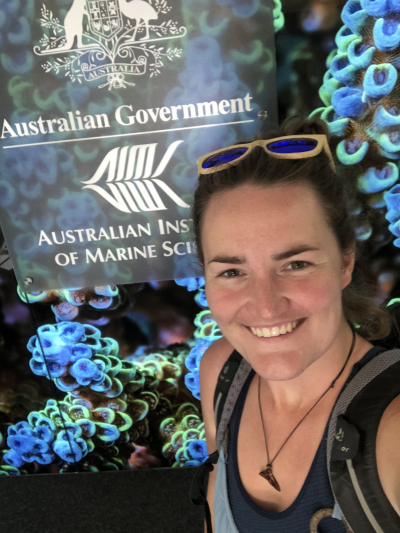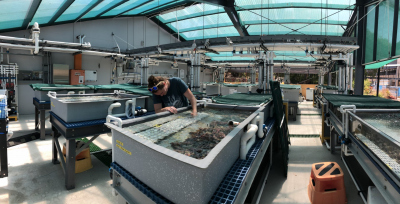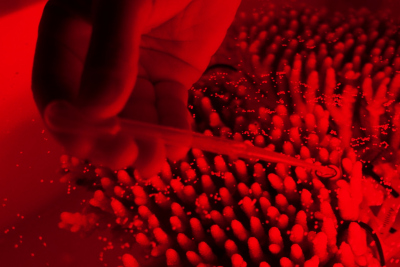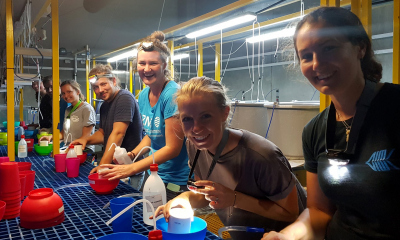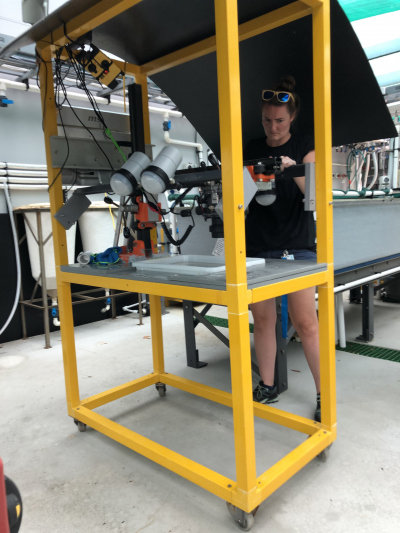Lisa Röpke
Report of GLOMAR PhD student Lisa Röpke about her research placement in Australia, Townsville, at the Australian Institute of Marine Science (AIMS) from 16 October 2019 to 14 February 2020
I was lucky enough to get invited for a research stay at the Australian Institute of Marine Science in Townsville, Australia, partly funded by the GLOMAR graduate school of the Center for Marine Environmental Sciences (MARUM) at the University of Bremen. The time abroad has been very intense, but totally worth all the sweat and organization prior and during this period. Before I actually saw the facilities at AIMS, I had already imagined pictures in my head from stories and photos I read. Now, being back in Germany, I can confidently say that AIMS and the National Sea Simulator (SeaSim) are a true playground for coral reef scientists. This place proved to be a highly developed technological natural seawater running facility with millions of options to set up experiments under a diverse range of conditions. I felt totally overwhelmed and happy at the same time because I knew that I’ve always wanted to work in such an environment. Since AIMS is a governmental agency, safety at work is important at all times and before any project related work could start, many laboratory inductions needed to be completed. However, after I made it through the “administration jungle”, the planned pilot experiments were discussed together with the collaborating scientist and ecotoxicology expert Dr. Andrew Negri and other local scientists at AIMS, Dr. Carly J. Randall and Dr. Florita Flores.
Prior to the coral spawning in November, coral colonies from the Palms and Keppels islands in the Great Barrier Reef were brought to the marine aquaria facilities in the SeaSim with the AIMS research vessel. The coral colonies stayed in the seawater tanks for a couple of nights until three nights after full moon different colonies of the same species Acropora millepora spawned and released their gametes into white nally bins. The positively buoyant gamete bundles were pipetted into smaller containers and transferred to another aquaria room for separation and washing of sperm and eggs. Afterwards, cross-fertilization of different colonies was processed in bigger containers and after a only about 1-2 hours, the fertilized eggs had developed into fully functional and actively swimming coral larvae. The larvae were transferred into rearing tanks with a filtered seawater volume of 400 L each. After this night shift, the larvae tanks were checked almost every hour in order to keep the larvae healthy for all scientists who had planned to use them in their experiments. This procedure kept going for 2 weeks after spawning.
When the larvae were a couple of days old, I started to set up some settlement assays with Crustose Coralline Algae (CCA) chips and what researchers at AIMS nicely call “fairy dust”. It basically means small shredded CCA powder, which is attractive for coral larvae and induces settlement behavior. Later on, also CCA extract was used to induce coral larvae settlement behavior. The settlement trials were tested on different surfaces, including my specific anti-biofouling coated surfaces. Also, larvae were used for swimming behavior testings and biofilm developments on the coated surfaces were monitored fortnightly with a very nice camera trolley and full frame camera built by technicians and engineers in the workshop at AIMS, specifically adapted to the needs of coral scientists.
All in all, this research stay proved to be more than fruitful from different points of view. I have learned to work in a very sophisticated scientific environment with many experienced and well-known scientists in my research field and also the collaborating researchers have pronounced their interest in future collaborations and knowledge exchange with me and the Leibniz Centre for Tropical Marine Research (ZMT) in Bremen. First insights into the work of this collaboration will be shared at the ICRS conference in Bremen this year and the Australian researchers will also be here to join interesting conversations about past, present and future scientific investigations.



